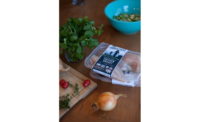How Chicken Products Can Benefit From Reclosable, Flexible Packaging

Maintaining the right atmosphere in packaging with proper film materials and closure technology is important for chicken products. (Photo by Aisyaqilumar | Adobe Stock)

Recloasable flexible packaging offers a number of benefits to chicken brands, packagers, and consumers. (Photo by lightpoet | Adobe Stock)

Flexible packaging with compatible closure technology creates a strong moisture barrier that helps improve product shelf-life. (Photo by Fresh-Lock).



When the COVID-19 pandemic began in early 2020, consumer dining habits dramatically changed – possibly for the long-term. A special report by food industry firm HUNTER says 51% of Americans continue to cook more, and 71% of those who have been cooking at home intend to continue the habit to save money, eat healthier, and feel better.
According to the National Chicken Council (NCC), Americans have been relying on chicken as a healthy and convenient protein as part of this trend. A survey revealed that half of Americans who eat chicken say they have eaten it more than any other protein during COVID-19.
As chicken brands and packagers search for ways to meet demand and appeal to this new market of at-home chefs, reclosable flexible packaging is a key tool they can offer for product protection and a better consumer experience.
How Flexible Packaging and Closures Work Together
Nothing ruins dinner plans faster than spoiled chicken – freezer burn, mold, or discoloration can disappoint home chefs and create unnecessary food waste. Luckily, improved technologies in reclosable flexible packaging for chicken have created greater ability to keep products fresh longer for a better consumer experience.
Whether consumers are planning to prepare meals with frozen, deli, or processed chicken products, the right quality of film material paired with a compatible closure will create an ideal package.
How does it work? Flexible packaging with closure technologies help extend shelf life by helping keep oxygen out and maintaining a moisture barrier that slows moisture transmission rates. Once the sealed package is opened by the consumer, oxidation – the chemical process responsible for the deterioration of food quality and accompanying foul odor – begins.
By squeezing out air then zipping the pouch closer, in combination with proper refrigeration or freezing, reclosable flexible packaging helps maintain the texture and quality of the chicken and creates a positive experience for the end user.
Keeping Chicken Fresh from Day One
Consumers want their chicken products to maintain the same quality as the day they bought them in the store. They want to be assured that the food they’re taking out of the package has been protected, from the first time they open the flexible package to the very last use. Audible closures – those that make a distinctive zip or click-click-click sound upon opening or closing – help reinforce confidence that the package is properly sealed and helping keep the product safe.
Audible closures also are particularly helpful for parents working with kids who may be helping to make sandwiches and other simple meals. When parents hear the audible zipper closure, they’ll know the package is being closed properly, helping keep the food ready for the next use.
Another benefit of a secure closure: leakage prevention. Consumers expect they won’t have to clean up a leaky or dangerous mess inside the refrigerator or freezer. They will feel confident that the package stayed closed, helping maintain the quality of the chicken. Even the act of opening the seal itself offers consumers the signal of freshness when an appetizing aroma is released from products like deli meats.
The Right Kind of Packaging and Storage
As consumers stay home to cook, demand for frozen foods continues to climb. One study shows the frozen ready meal market – with chicken meals as the top-selling frozen meal product – is set to reach $47 billion by 2026.
For frozen chicken products, maintaining the integrity of the reclosable flexible packaging inside the freezer is important to consumers who depend on the product being ready and available when it comes to mealtime prep.
An improperly sealing package will cause a consumer to repackage items, meaning they’re having a less-than-ideal experience. On top of that, the consumer no longer has the original branding of the chicken product. They may not even remember the brand and may be less likely to purchase a product that requires the extra work and effort of having to repackage their items at home.
Worse, they may lose the confidence that the product will maintain its quality and freshness. Will they buy it again? Or will they choose another item? There’s a security and comfort that comes with high-quality, well-designed flexible packaging with reclosable properties.
Packaging Enhances Sustainability
Proper packaging also can ensure greater sustainability throughout the stream. It keeps more food out of the waste stream. Additionally, reclosable flexible packaging offers sustainability benefits throughout its lifecycle, using fewer resources in production than other types of rigid packaging. Within manufacturing, the right film and zipper combination creates an efficient production process that helps reduce waste. When the film and zipper match, producers gain the output they’re seeking, and the consumer has a strong experience that ideally ends with them placing the packaging back into the stream for recycling.
Keeping Chicken Fresh at Home
Chicken product brands and packagers should ask themselves: What’s the best packaging option to maintain product quality? What kind of flexible packaging and closure will signal to the consumer that they’re having the most valuable experience with the product they brought home? How can we ensure consumers have the same experience the fourth time they open a package as the first time?
When a consumer feels confident in the safety and efficacy of the packaging and they have a good experience with the product with each use, they will be more likely to buy it again.
Looking for a reprint of this article?
From high-res PDFs to custom plaques, order your copy today!










